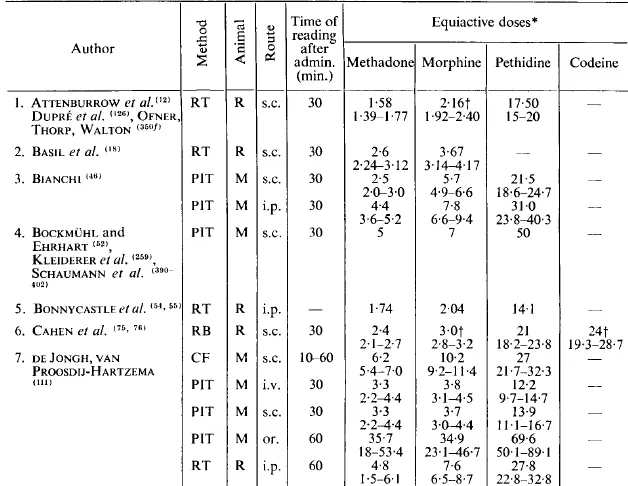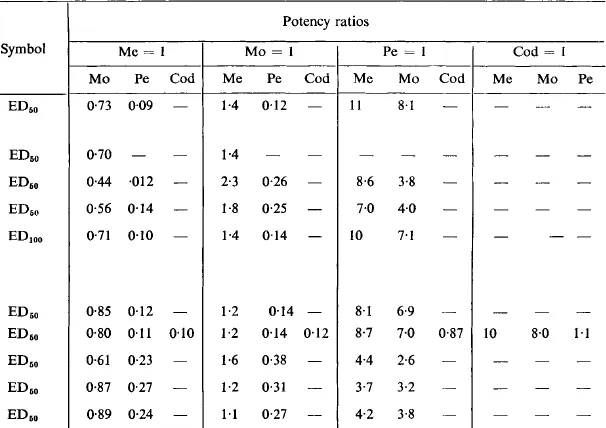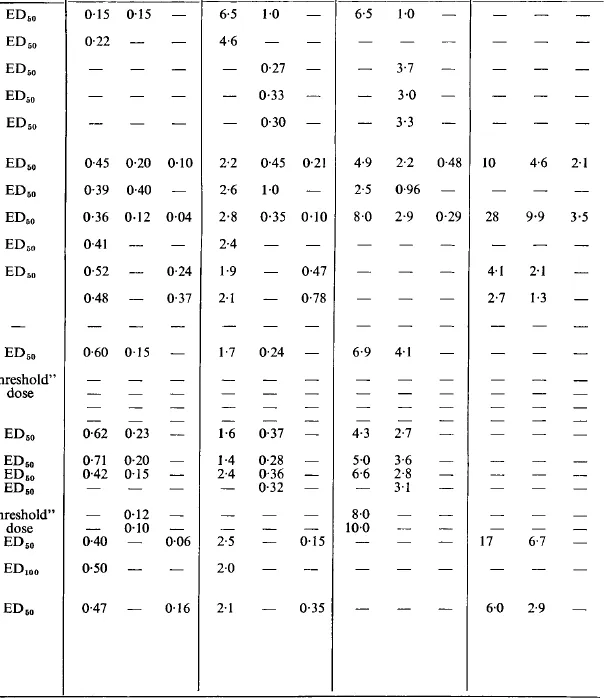![]()
CHAPTER I
“Analgesic” Activity in Man and in Animals
Publisher Summary
Analgesics are the compounds that are capable of relieving pain. In man, pain can be evoked by various noxious stimuli, such as heat, pressure, chemicals, and electric current. In view of the fact that pain is, by definition, a subjective sensation of mankind, it can only be studied in humans. Numerous ingenious means of inflicting pain that is quantifiable in mechanical, thermal, electrical, or chemical units of measurement have been devised. However, the main difficulty in interpreting the various results obtained by different authors originates from the fact that the reproducibility and standardization of the methods is a neglected problem. The first requirement for an ideal pharmacological method is that it should be reproducible by every investigator who follows exactly the directions given in a description of the method. To find out whether such descriptions exist at all, the whole problem of the standardization of pharmacological methods should be investigated by collaborative experimentation in many laboratories.
A compound is said to possess “analgesic” activity when it is capable of relieving pain. Pain, of course, is a universal subjective experience of mankind, and everybody knows what is meant by it (39). Hence there is no point in trying to define this basic concept.
In man, pain can be evoked by various “noxious” stimuli, such as heat, pressure, chemicals, electric current, etc. When such stimuli are applied to animals, their behaviour changes in a typical way. Generally speaking the animal either tries to avoid the stimulus by various flight reactions or, when flight is made impossible, it shows a series of reflexes, which are often interpreted as signs of discomfort. In man, the evidence on whether or not pain is relieved, is entirely based on the statement of the subject as expressed in the interview made by the observer. The nature of such statements, however, depends on several factors in constant operation, such as the willingness of the subject to talk about his feelings, the attitude of the observer towards the subject, the influence of the environment on the subject, his immediate problems, his hope or desperation and many other factors.
Obviously, therefore, the study of the influence of one single factor, such as the administration of a drug, on the statements of a given subject necessitates special techniques. The elimination of bias on the part of the subject or the observer emerges clearly as a basic and essential requirement for such studies (39). Recently, the various problems concerning the measurement of pain and relief of pain were adequately reviewed by Beecher (39).
In view of the fact that pain is, by definition, a subjective sensation of mankind, it can, strictly speaking, only be studied in humans. What we are able to study in animals is not pain itself, but the behaviour of the animal following a stimulus which provokes pain in man and also, of course, the influence of a given factor, such as the administration of a certain drug on the reactions of the animal. Rather full fists of references to the methods of producing “pain” for experimental purposes are given by Beecher (39) and O. Schaumann(402). Numerous ingenious means of inflicting pain which is quantifiable in mechanical, thermal, electrical or chemical units of measurement have been devised.
All possible species, routes of administration, criteria of “effectiveness” or “analgesic activity” and methods of symbolization and statistical analysis have been used, and many other modifications of known methods will undoubtedly be published in the future.
The main difficulty, however, in interpreting the various results obtained by different authors, originates from the fact that the reproducibility and standardization of the methods is a neglected problem. The evidence, presented in the next chapters, shows that significantly different results have often been obtained by investigators, claiming to use the same method. There are several possible reasons for this:
(1) The description of the original method may have been insufficient for the purpose of exact duplication.
(2) Unknown neglected and unexpected factors (race, food, body-weight, handling of the animal, amount and nature of solvent, impurity in sample, previous treatment, season, etc.) may have been responsible.
It should be more generally realized, in our opinion, that the first requirement for an “ideal” pharmacological method is that it should be reproducible by every investigator who follows exactly the directions given in a description of the method. In order to find out whether such descriptions exist at all, the whole problem of standardization of pharmacological methods should be investigated by collaborative experimentation in many laboratories.
These considerations and restrictions should be kept in mind when reading the following chapters.
![]()
CHAPTER II
The “Analgesic” Activity of Methadone, Morphine, Pethidine and Codeine in Animals
Publisher Summary
The analgesic activity of diphenylpropylamines are expressed in quantitative symbols, equiactive dose, ED50-doses, threshold doses, or potency ratios. The usual standards of reference are morphine, methadone, and pethidine. This chapter discusses the quantitative results obtained in 50 experimental conditions with these compounds and with codeine by 28 authors. Nearly all authors found methadone more active than morphine, morphine more active than pethidine, and pethidine more active than codeine by subcutaneous injection in both rats and mice. The chapter also presents the analgesic potency ratios of methadone, morphine, pethidine, and codeine as determined by subcutaneous injection in mice and rats in 46 different experimental conditions. The results show that there is no detectable correlation between equiactive dose level and potency ratio. The potency ratios and equiactive dose levels determined after intraperitoneal injection injection are not significantly different from those obtained after subcutaneous injection.
The vast majority of published data concerning the “analgesic” activity of diphenylpropylamines of structure (I) are expressed in quantitative symbols, i.e. “equiactive” doses, ED50-doses, “threshold” doses or potency ratios.
The usual standards of reference are morphine, methadone and pethidine. The quantitative results obtained in fifty experimental conditions with these compounds and with codeine by twenty-eight authors, referred to in the following chapters, are listed in Table II. The following experimental factors are summarized in this table:
TABLE II
‡ Phosphate.
*All hydrochlorides, unless otherwise indicated, in mg/kg.
†Sulphate.
*All hydrochlorides, unless otherwise indicated, in mg/kg.
†Sulphate.
(1) Species: R (rats), M (mice), G (guinea pig), Rb (rabbit) and D (dog).
(2) Method, c...






